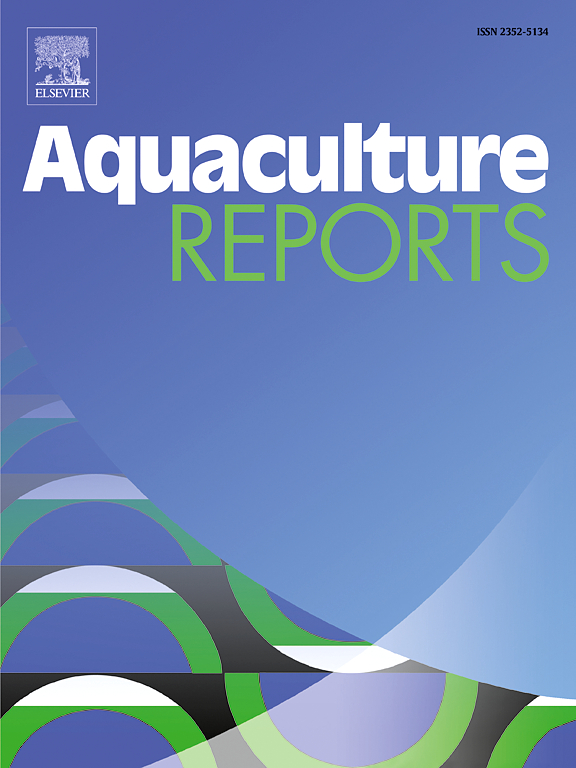Composite single-cell protein as a sustainable fishmeal substitute: Enhancing growth and health in largemouth bass (Micropterus salmoides)
IF 3.2
2区 农林科学
Q1 FISHERIES
引用次数: 0
Abstract
This study evaluated the potential of a composite single-cell protein (CSCP) containing Chlorella vulgaris and Clostridium autoethanogenum at a 1:4 ratio as a substitute for fishmeal (FM) in largemouth bass (Micropterus salmoides) feed. A 56-day trial assessed CSCP's effects on disease resistance, antioxidant capacity, immune response, digestive function, and intestinal microbiota. Three diets were formulated: the control diet (FM52) with a high proportion of FM, the FM26 diet with 50 % of the FM replaced by CSCP, and the FM0 diet with complete FM replacement by CSCP. Three groups of 360 largemouth bass (initial average weight: 4.00 ± 0.03 g) were assigned to diets with three replicates of 40 fish each. Exposure to Aeromonas hydrophila resulted in higher survival rates (SR) in CSCP-supplemented groups, with the FM26 group showing the highest SR. Serum biochemical analysis indicated that CSCP improved lipid metabolism and liver health, evidenced by changes in triglycerides, cholesterol, alanine aminotransferase and aspartate aminotransferase. Antioxidant defense was strengthened with increased superoxide dismutase, peroxidase, and glutathione activities, and reduced malondialdehyde, indicating reduced oxidative stress. Gene expression analysis showed that the anti-apoptotic bcl-2 and anti-inflammatory il-10 genes were up-regulated, while the pro-apoptotic casp3 and casp9 as well as the pro-inflammatory tnf-α and il-8 genes were down-regulated. Intestinal digestive enzyme activities (trypsin, α-amylase, lipase) were enhanced, and intestinal microbiota composition was altered, with an increase in potential beneficial bacteria (Cetobacterium, Clostridium_sensu_stricto_1) and a reduction in potential pathogens (Mycoplasma, Aeromonas) in the FM26 group. Functional predictions indicated enhanced pathways in “Cell motility” and “Immune system,” with enrichment of the NOD-like receptor signaling pathway. In conclusion, CSCP is a promising FM substitute, improving disease resistance, antioxidant capacity, immune response, digestive function, and intestinal microbiota in largemouth bass, with the FM26 diet yielding the most optimal results. This study provides valuable insights for sustainable aquaculture feed optimization.
复合单细胞蛋白作为可持续的鱼粉替代品:促进大口黑鲈的生长和健康
本研究评价了普通小球藻和自产乙醇梭菌按1:4的比例配制复合单细胞蛋白(CSCP)作为大口黑鲈饲料中鱼粉(FM)替代品的潜力。一项为期56天的试验评估了CSCP对疾病抵抗力、抗氧化能力、免疫反应、消化功能和肠道微生物群的影响。配制出3种饲粮,分别为高鱼粉比例的对照饲粮(FM52)、50 %鱼粉被CSCP替代的FM26饲粮和完全用CSCP替代鱼粉的FM0饲粮。选取初始平均体重为4.00 ± 0.03 g的3组大口黑鲈360尾,每组3个重复,每个重复40尾。暴露于嗜水气单胞菌中,CSCP添加组的存活率更高,其中FM26组的存活率最高。血清生化分析表明,CSCP改善了脂质代谢和肝脏健康,甘油三酯、胆固醇、丙氨酸转氨酶和天冬氨酸转氨酶的变化证明了这一点。抗氧化防御增强,超氧化物歧化酶、过氧化物酶和谷胱甘肽活性增加,丙二醛降低,表明氧化应激减轻。基因表达分析显示,抗凋亡基因bcl-2和抗炎基因il-10上调,促凋亡基因casp3和casp9以及促炎基因tnf-α和il-8下调。肠道消化酶活性(胰蛋白酶、α-淀粉酶、脂肪酶)增强,肠道菌群组成发生改变,潜在有益菌(Cetobacterium, clostridium_sensen_stricto_1)增加,潜在致病菌(Mycoplasma, Aeromonas)减少。功能预测表明“细胞运动”和“免疫系统”通路增强,nod样受体信号通路富集。综上所述,CSCP是一种很有前景的鱼粉替代品,可提高大口黑鲈的抗病能力、抗氧化能力、免疫反应、消化功能和肠道微生物群,其中FM26日粮效果最佳。本研究为水产养殖饲料的可持续优化提供了有价值的见解。
本文章由计算机程序翻译,如有差异,请以英文原文为准。
求助全文
约1分钟内获得全文
求助全文
来源期刊

Aquaculture Reports
Agricultural and Biological Sciences-Animal Science and Zoology
CiteScore
5.90
自引率
8.10%
发文量
469
审稿时长
77 days
期刊介绍:
Aquaculture Reports will publish original research papers and reviews documenting outstanding science with a regional context and focus, answering the need for high quality information on novel species, systems and regions in emerging areas of aquaculture research and development, such as integrated multi-trophic aquaculture, urban aquaculture, ornamental, unfed aquaculture, offshore aquaculture and others. Papers having industry research as priority and encompassing product development research or current industry practice are encouraged.
 求助内容:
求助内容: 应助结果提醒方式:
应助结果提醒方式:


